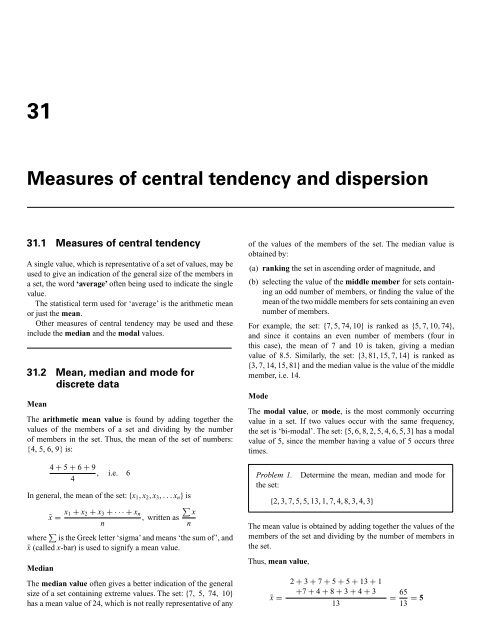basic_engineering_mathematics0
You also want an ePaper? Increase the reach of your titles
YUMPU automatically turns print PDFs into web optimized ePapers that Google loves.
31<br />
Measures of central tendency and dispersion<br />
31.1 Measures of central tendency<br />
A single value, which is representative of a set of values, may be<br />
used to give an indication of the general size of the members in<br />
a set, the word ‘average’ often being used to indicate the single<br />
value.<br />
The statistical term used for ‘average’ is the arithmetic mean<br />
or just the mean.<br />
Other measures of central tendency may be used and these<br />
include the median and the modal values.<br />
31.2 Mean, median and mode for<br />
discrete data<br />
Mean<br />
The arithmetic mean value is found by adding together the<br />
values of the members of a set and dividing by the number<br />
of members in the set. Thus, the mean of the set of numbers:<br />
{4, 5, 6, 9} is:<br />
4 + 5 + 6 + 9<br />
, i.e. 6<br />
4<br />
In general, the mean of the set: {x 1 , x 2 , x 3 , ...x n } is<br />
¯x = x ∑<br />
1 + x 2 + x 3 +···+x n<br />
x<br />
, written as<br />
n<br />
n<br />
where ∑ is the Greek letter ‘sigma’ and means ‘the sum of’, and<br />
¯x (called x-bar) is used to signify a mean value.<br />
Median<br />
The median value often gives a better indication of the general<br />
size of a set containing extreme values. The set: {7, 5, 74, 10}<br />
has a mean value of 24, which is not really representative of any<br />
of the values of the members of the set. The median value is<br />
obtained by:<br />
(a) ranking the set in ascending order of magnitude, and<br />
(b) selecting the value of the middle member for sets containing<br />
an odd number of members, or finding the value of the<br />
mean of the two middle members for sets containing an even<br />
number of members.<br />
For example, the set: {7, 5, 74, 10} is ranked as {5, 7, 10, 74},<br />
and since it contains an even number of members (four in<br />
this case), the mean of 7 and 10 is taken, giving a median<br />
value of 8.5. Similarly, the set: {3, 81, 15, 7, 14} is ranked as<br />
{3, 7, 14, 15, 81} and the median value is the value of the middle<br />
member, i.e. 14.<br />
Mode<br />
The modal value, ormode, is the most commonly occurring<br />
value in a set. If two values occur with the same frequency,<br />
the set is ‘bi-modal’. The set: {5, 6, 8, 2, 5, 4, 6, 5, 3} has a modal<br />
value of 5, since the member having a value of 5 occurs three<br />
times.<br />
Problem 1.<br />
the set:<br />
Determine the mean, median and mode for<br />
{2, 3, 7, 5, 5, 13, 1, 7, 4, 8, 3, 4, 3}<br />
The mean value is obtained by adding together the values of the<br />
members of the set and dividing by the number of members in<br />
the set.<br />
Thus, mean value,<br />
¯x =<br />
2 + 3 + 7 + 5 + 5 + 13 + 1<br />
+7 + 4 + 8 + 3 + 4 + 3<br />
13<br />
= 65<br />
13 = 5















![[Lonely Planet] Sri Lanka](https://img.yumpu.com/59845622/1/169x260/lonely-planet-sri-lanka.jpg?quality=85)

